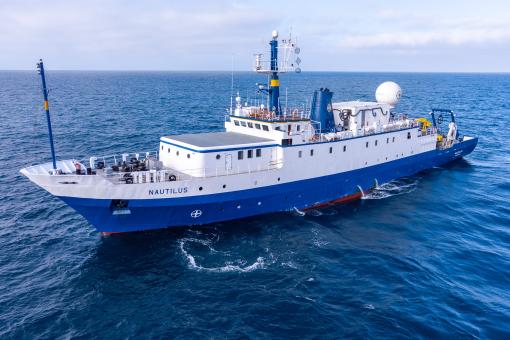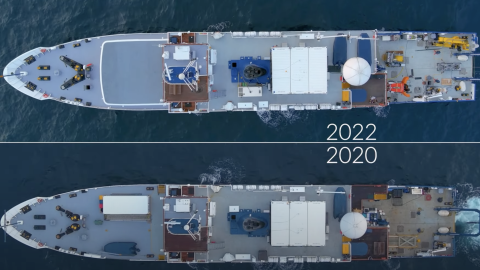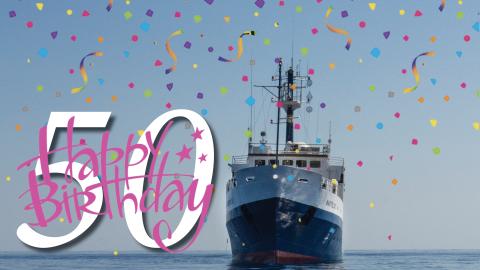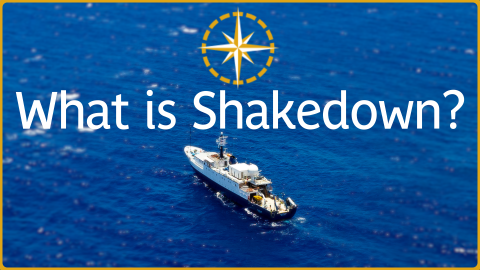E/V Nautilus

Welcome Aboard E/V Nautilus
Exploration Vessel (E/V) Nautilus is owned and operated by the Ocean Exploration Trust (OET), a 501(c)(3) nonprofit established to explore the world’s oceans to seek out new discoveries in the fields of geology, biology, maritime history, archaeology, and chemistry.
OET was founded in 2007 by Dr. Robert Ballard to engage in pure ocean exploration. Inspired by Ballard’s discovery of the wreck of the Titanic and the first discovery of hydrothermal vents, it is our organization-wide mission to develop and utilize technologies that enable us to push the boundaries of ocean exploration and to share these discoveries with global audiences through around-the-clock telepresence and immersive resources for students and educators.
The ship is operated by 17 permanent crew members in addition to 35 berths for members of the rotating Corps of Exploration, including scientists, engineers, educators, and artists from around the world who serve as role models for the next generation of explorers interested in STEM career pathways.
E/V Nautilus is homeported at AltaSea at the Port of Los Angeles in San Pedro, California. Since 2008, Nautilus has explored waters across the world, moving from the Black Sea and Mediterranean Sea into the Atlantic Ocean, Caribbean Sea, Gulf of Mexico, and crossing through the Panama Canal to the Pacific Ocean in 2015. Her current focus is on exploration throughout the Pacific Ocean.
Nautilus was built in 1967 in East Germany as a fisheries research vessel under the original name Georgius Agricola, before becoming Alexander Von Humboldt, and eventually being procured and retrofitted into a deep-sea exploration vessel in 2008 by OET.
Learn More: Mission and Goals
Novel Oceanic Research
Seagoing operations are dedicated to conducting all scientific research to the highest international academic standards as we push the boundaries of ocean engineering, technology, education, and communication.
Exploratory missions of our 68-meter (224 foot) exploration vessel include the testing of innovative scientific instruments and systems, mapping technologies, site characterization procedures, at-sea data analysis, and understanding and exploring our world’s oceans – all shared live to spread the excitement of ocean exploration and turn everyday viewers into explorers.
Expeditions are planned in conjunction with federal agencies, marine sanctuaries, media organizations, and research institutes whose missions align with our own, including the National Oceanic and Atmospheric Administration (NOAA) Office of Ocean Exploration and Research, NOAA Office of National Marine Sanctuaries, National Geographic Society, and other organizations. As of 2019, Ocean Exploration Trust joined a newly-formed NOAA Ocean Exploration Cooperative Institute alongside the University of Rhode Island, Woods Hole Oceanographic Institution, University of New Hampshire, and University of Southern Mississippi, to drive a new generation of exploration technology, innovation, and outreach capabilities.
Learn More: Our Partners & Sponsors
Technology to Explore the Ocean’s Deepest Depths
Nautilus has traveled the planet in search of the ocean’s unknown regions, including the rediscovery of the wreck of the USS Independence, surveying underwater volcanoes and bubbling methane seeps, and introducing some of the world’s most loved cephalopods, like the googly-eyed stubby squid and the brooding octopus garden located in Monterey Bay National Marine Sanctuary.
The ship is equipped with a two-tiered approach to ocean exploration. First, the team uses a multibeam sonar system mounted on the hull of the ship to acquire data that our team uses to produce maps of the seafloor. Once the data is analyzed and areas of interest are identified, we deploy ROVs to collect video footage and a variety of biological, geological, chemical, and archaeological samples.
Innovation and progress are at the forefront of our expedition through our use of robotic vehicles, data collection, state-of-the-art sensors and samplers, deployable mobile systems, robotic vehicles, telepresence, and live streaming capabilities, as well as insight from scientists located around the world. Aboard the vessel, our data and wet labs are used for processing digital data and physical samples.
Science & Tech
Ocean exploration is a dynamic balance of understanding science and using the best in underwater technology.
Expeditions
Get a sneak peek of where we're headed next or revisit the discoveries of our past expeditions.
Classroom Resources
OET hosts a suite of free educational materials for use in classrooms, at home, or in the community.
Ship Specifics At-a-Glance
General
- 1967, Rostock, Germany
- 68.23 meters (224 feet)
- 10.5 meters (34.5 feet)
- 4.9 meters (16 feet)
- 1,249 gross, 374 net
- 24,000 kilometers (13,000 nautical miles) at 10 knots
- 40 days at sea
- 10 knots service, 12 knots maximum
- 330 cubic meters
- Single 1,285 kilowatt (1,700 hp) controllable pitch main thruster; 280 kW bow tunnel thruster; 300 kW jet pump stern thruster
- Two 585 kVA generators, one 350 kVA generator
- Four 6.1 meter (20 feet) vans
- 17 crew; 35 science and operations
- St. Vincent and the Grenadines
- Dynacon 369i traction ROV winch with 7,000 meters (23,000 feet) of 1.73 centimeter (0.681 inch) diameter electro-optic Rochester cable
- DT Marine 210 winch
- Bonfiglioli P30500XL-4Si knuckle-boom crane, 2–6 ton capacity, two extensions
- Guerra M660.24AJ1 foldable knuckle-boom crane, SWL 4.5 ton at 8.3m
- Hawbolt painter boom with winch, 1.5 metric tons safe working load with 7-meter reach off starboard sideTwo airtuggers, SWL 900 lbs each
- A-frame, SWL 8 tonnes
- Two Rescue boats, crane and davit with SWL 0.9 metric tons
Telepresence Technology
- 2.4 meter axis stabilized Sea Tel 9711 uplink antenna capable of C- and Ku-band operation of up to 20 Mbps (C-band circular or linear)
- Six Haivison X Encoders streaming live video via satellite to the Inner Space Center ashore
- 24 high-definition pan/tilt/zoom cameras: aft port, amid and starboard (pan/zoom/tilt), 180° wide aft, transom, bow, command center (8), wet lab, ROV hangar, winch hold (6)
Communications
- Ship-wide RTS Odin intercom system for shipboard communications and connection with shoreside participants
- Software audio connection for global participants using VLink multi-platform intercom client (Mac, Windows, Android, iOS)
- Telephone interface is available through a Rhode Island exchange for real-time collaboration between scientists ashore and on the ship
- Full Internet connectivity from shipboard LAN and wifi
- KVH TracPhone-v7 for redundant bridge communication, providing telephone and IP service
Data Processing & Visualization Lab
- 44.5 square meters (480 square feet)
- Eight workstations for science manager, data loggers, navigators, educators, data engineers, satellite engineer, video engineer; seafloor mapping data processing; flexible bench space
Rack Room
- 17.3 square meters (185 square feet)
- 50 TB onboard storage for non-video data; 150 TB disk storage for video data
- Iridium phone, KVH phone
- 2.3 cubic meters (80 cubic feet) of storage
Production Studio
- 12 square meters (130 square feet)
- UHD 4K Panasonic BGH1 studio camera ; Sony A1 camera kit for topside video with live broadcast capacity via Teradek 500
- 10-input video production switcher for live-produced interactions; full production editing workstation with ship-to-shore transmit capacity for remote production needs
Wet Lab
- 19 square meters (204.5 square feet) with 5.3-meter-long (17.5-foot) stainless steel bench and 2.3-meter-long (7.6-foot) worktop
- Zeiss Primo Star Binocular Microscope, 4x, 10x, 40x, 100
- Panasonic MDF-C8V1 ULT –80/–86°C scientific freezer, 0.085 cubic meters (3 cubic feet)
- Two science refrigerators, approximately 0.57 cubic meters each (20 cubic feet each)
- Science freezer, -20°C, 0.14 cubic meter (5 cubic feet)
- Fume hood
- Two HAZMAT lockers for chemical and waste storage
- Carry-on, carry-off chemical policy
ROV Hangar
- 24 square meters (258.3 square feet)
- 110/60 Hz and 220/50 Hz available
- Hard hats, PFDs, high voltage gloves
- 2 × 2-ton overhead manual chainfall lifts
- Storage for spares and other equipment
ROV Workshop
- 18 square meters (193.8 square feet)
- Complete set of hand tools, cordless tools, electrical and fiber optic test equipment, mill-drill combination machine
- Storage for spares and other equipment
Control, Command & Outreach Vans
- 43 square meters (476 square feet)
- Twelve; typical configuration for ROV operations: two to four scientists, data logger, pilot and copilot, navigator, video engineer, educator
- Two Cinedeck ZX85 Video Recorders that capture ROV footage in two simultaneous codecs, two Blackmagic Hyperdeck Uncompressed 4K recorders, two AJA KiPro Go recorders, 2x LTO-6 archive media drives, 2x LTO-8 archive media drives
Example Technological Collaborations
- Woods Hole Oceanographic Institution | AUV Mesobot, HROV NUI, AUV Sentry
- University of New Hampshire CCOM | ASV DriX, ASV BEN, aerial drones
- University of Rhode Island | Deep Autonomous Profiler, Laser mapping system, Norbit multibeam sonar (on ROV)
- University of Hawaiʻi | Hadal Water Column Profiler
- Ocean Networks Canada | NEPTUNE Observatory, Argo float deployments
- National Geographic Society | Deep Ocean Drop Cameras
- SoFar Ocean Technologies | Spotter buoys
Coastal Observing and Research Development Center, Scripps Institution of Oceanography | Miniature wave buoys



